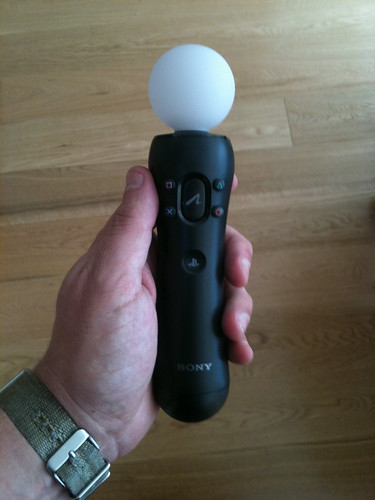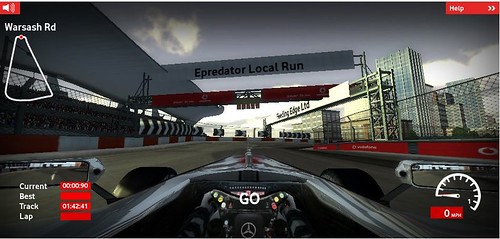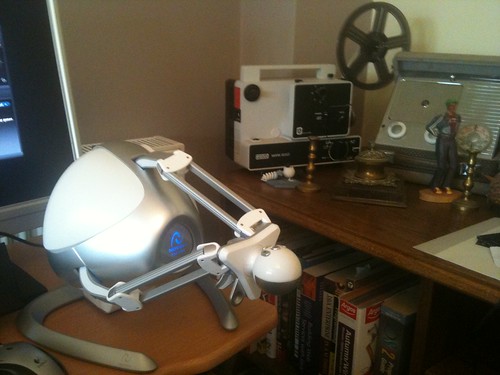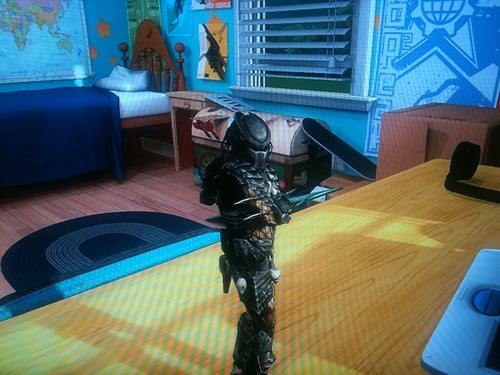I have to admit to having been a little dismissive of the Ps3 Move controllers. I should have known better really as if I get that dismissive feeling I usually dig a bit deeper to consider why and find the gem I am missing.
In this case it took getting a Move controller in the house and playing with it. I had only really seen the table tennis game we had on The Cool Stuff Collective show, which whilst it is great seemed very Wii like in what it did. Yes you have brilliant control over the bat but conceptually it is the same.
Anyway on Saturday the predlets and I wandered into our local Best Buy and I thought we should get 2 controllers.
Already having a camera and a few things like eye pet that could be upgraded it was worth it.

You have to charge the things up of course, but as you have to wait several hours for updates and demos to down load there was time for a charge.
The ball on the end of the controller changes colour depending on which controller it is in a multiple set. In the shop I was confused as to whether I needed the extra additional movement controller for anything. So I left that one where it was (more on that at the end of this)
Whilst mentally I have been all about Kinect on the 360 and the fantastic full body motion capture it does for control the Move controller really does some things that the Wii mote cannot do and to some extent that Kinect cannot do.
The Wiimote acts more as a 2d pointer, it does not deal with depth in the same way as a Move does. In addition the move is keyed into the camera. So the experiences are able to put you in the environment and then it is able to track the controller and replace it on screen with something else. See below with the foam hand.
This feedback loop is most noticeable in Eye Pet. The previous incarnation used a tracking marker of card that you moved around the augmented environment. It worked, but it you turned the card at an angle you would loose tracking (as the marker was 2d an obscured). The glowing move ball and its accelerometers know if you twist turn or angle the controller any direction and you can see that on screen with the augmented item. This makes eye pet even easier to use. It is more obvious to hold the glowing ball than a flat piece of card. The predlets got straight on with eye pet and were able to do even more and play the games better, so Move is worth it for Eye Pet alone.
This direct connection to the onscreen environment and the blended augmentation of the magic mirror effect does not feature in all games though.
However one feature that felt great is in the downloadable game Tumble. This is a block stacking game, a clone of Boom Blox on the Wii which allows for a good comparison of the evolution.
Tumble shows the Move as a laser pointer on the screen, but when you pick up a block you have to reach in and out of the screen as well as move in the 2d plane to stack the block. As you place the block you feel the very subtle feedback of the rumble pack. It is haptics lite but with the visuals and the physical activity the feedback loop is very believable. It is this feedback that Kinect will not be able to do. Obviously in a dance game on Kinect the feedback and avatar on screen movement will immerse but you will not feel anything from other experiences. In addition this Tumble game is 3d enabled (which I we are not yet!) but I ca imagine the 3d depth combined with the physical movements and tactile feedback will make this incredibly immersive.
Another tactile element to Move is the fire button in a “light gun” game. In some of the point and shoot games a trigger to press is very satisfying.
So you can see there is more to the comparison of Move and Kinect and Wiimote than meets the eye or hand.
Finally I got Resident Evil 5 as a Move compatible version. I don’t really like zombie games and whilst I appreciate the wonderful nature of Res Evil it always seems the controls CapCom use are counter intuitive. With the Move this was the same. The trigger is user to aim the gun and the thumb button to fire. In addition whilst this says Move compatible the boxes need to be a bit more clear whether you need 2 glowing ball controllers or 1 glow and one movement. Res Evil needs a joypad to move around. You can hold a six axis controller in your left hand and grapple with movement but really the smooth way is the extra extra controller. Not clear from the box (though obvious in some ways of you know the game). As Res Evil is quite a tricky game dealing with odd controls and not just shooting stuff meant it was not a great experience out of the box. I will persevere though.
It is a pity there was not a better line up of games at launch. Something that seems to be a very Sony thing to do. Lots of coming soon 2gb demos to wait to download (or on a disc if you buy the camera with the controller).
However, I like it now, it has a place and it will do some very interesting things IMHO.
games
A challenge to the closed minds – Not just game technology but game mechanics
I recently joined the panel at the Train for Success event in Second Life where we (Anders the host, Dusan Writer, Maria Korolov and myself) were there to discuss the pulling back from pure enterprise firewalled virtual world solutions by Linden Lab and a focus on the consumer experience. In part of that we talked about the various game related technologies that come into play in delivering a virtual world. Lots of the focus, quite naturally, is on the front end though I did point out the challenge of any MMO is the server based synchronization. In many ways we can get a browser or client to do all sorts of wonderful immersive stuff but its much harder to share a lag free experience and distribute to those clients.

It was interested to take the role of the “techy who knows a bit about game platforms”.
All of us responded in pretty much the same way that yes enterprise SL was not packaged and sold right, nor given the time to evolve but that we all use Second Life still as we blend business and social in so many ways. It was where I started to get traction with my colleagues and customers in 2006.
At the end we got onto what needs to extend to an even more interesting conversation as whilst the technology can continue to evolve and get better, faster etc it is the things we do with it and the creative endeavours that create interest and engage people.
Whilst there was an uphill battle to get the more mainstream business people to get over the apparent frivolous nature of avatar mediated communication this next wave is really go to scare them and challenge them.
Many of the IT departments and policy makers have decided “We don’t play games at work on our PC’s” that is the mantra used to block the use of anything remotely interesting. It is not without some reason, but the seed of reason grows into a giant forest of objection and darkness. Explaining, or showing that places like Second Life and Opensim etc are not games, just game technology used for another reason doesn’t always chop down the forest.
Now of course there is the gamification wave. The implementation of game mechanics and ideas into every application and walk of life. Business is a game, saying the right things to get that promotion is a game, getting the promotion is a badge earned and worn, winning the sales competition and going on a jolly is like a rewarding cut scene after a tough mission.
Many of these game mechanics, remembering the IT department “we don’t play games at work” mantra will not even touch any of the IT systems in a way they will notice. An Alternate reality campaign inside a corporation may use the phone system, emails, noticeboards etc. All hiding the game elements as a payload inside everyday tools.
At some point though, someone, somewhere, is going to say why cant we do this in a wonderful hi rez generated environment? Why cant we use gesture control like Kinect to navigate the sales figures.
It is a conceptual revolution with a massive social impact, as much as social media and the web. Screwing together plates on a production line is very hard to alter as a physical process to make it less soul destroying. Motivations of speed and efficiency and money for the worker help but ultimately it gets automated. The digital chores we make for ourselves clearly can be altered, you have a family photo as a backdrop on your desktop as a start.
There is a great article from the Harvard Business Review here I know statistics don’t work for the closed of mind as they will discount things that do not meet their believes but this is an interesting quote.
“At SCVNGR, we’ve been able to examine the statistical effects of introducing game dynamics into situations that are decidedly not games. We’ve seen simple game dynamics increase traffic to locations 4X over a matter of days. We’ve seen others extend the average amount of engaged time consumers spend at a business by upwards of 40%.”
Game mechanics motivate and entertain people. People pay to play games that are chores. Surely its in all the more straight laced and ROI induced business people to look at what they and their people do and see if they can spruce it up a bit. Bored or scared people are going to just do the least they need. Motivated and excited people are going to do great things.
So straight laced serious business people who use ‘this is the way we have always done it” whats the point of that…. people the ball is in your court (oh look another gaming/sporting reference).
Unity3d, F1, Google Maps mashup
A very neat application surfaced this weekend via tweets by @robotduck. An official Vodafone F1 application lets you build the profile of a track you race from the roads on google maps.
Its called Hometown as they clearly have spotted most people will razz around racetracks near their own homes.
Not only that they let you add extra furniture to the tracks, landmarks and barriers, including yout own text banners.

It is very cool and uses unity3d
Pushing the envelope – Literally
After recording the Cool Stuff Collective second episode using the Haptic 3d device it made sense to get one and see what the predlets, and maybe their school, could do with one. Whilst the haptic show does not air until 20th September I thought it was worth sharing some initial impressions of ownership. Basically it awesome !
The entire package is called Chameleon 3d from A1 Technologies. A1 Technologies are the UK distributor of both the Novint Falcon (The haptic device) and the Anarkik3d Cloud 9 modelling package
The Falcon has a self contained set of mini games and tutorial demos. Although windows drivers tend to be a bit of a pain if you follow the right instructions it dos just work first time. The initial demo lets you feel a number of textures and forces rough, smooth, magnetic, rubber, honey etc. It makes for a very impressive feel for the potential.
Whilst I did spark up the haptic patch for Half Life 2 I was more interested in the creative modelling of Cloud 9 for the moment (more on virtual world and game navigation in another post)

Here is the Falcon nestled with some much older tech gadgets.
The Falcon is quite a large device but sits on a nice sturdy base. It needs some weight to be able to offer resistance and not zoom across the desk. The footprint is about the same as the old microsoft sidewinder force feedback sticks I used to have for Combat Flight Sim.
On Cloud9 I dived straight in and in time honoured tradition “it all started with a cube”.
I pushed, prodded and deformed the cube both from the outside and from the inside too.
The video shows the resulting modified cube, then it published to Unity3d as an OBJ file. Finally it shows predlet 1.0 having a go. It really is very intuitive and very compelling to model with. I have a few ideas of things I want to try but like any modelling tool that also needs some inspiration and talent. As the creation can be exported as OBJ (or STL if you want to 3d print them) then can of course be put into other 3d packages to have extra effects applied.
Now when are Second Life going to sort out meshes 😉 I can generate some very organic structures then even as a techie.
If you want to see the actual unity3d spin around it is here I published it from the free windows version as my Mac paid for version is on the version 3 beta and so cant publish to the web yet.
BTW it was using this that predlet 1.0 uttered the immortal words “Dad, I love you job its way cool” 🙂
Fiducial Markers and Unity 3d
I was looking around for a quick way to use the wonderful Reactivision camera based marker tracking. Ideally I really wanted a fully working Reactable, but without a projector and the music and light software and the physical elements like a glass table I cant really do what I want to do in the time I need to do it.
I bumped into a project from a few years ago the tangiblaptop that was aimed at using the laptop screen rather than a projector to display the things that happen to the markers that are also placed on that surface but picked up by the camera. It looked good but I thought I needed something with a bit more variety.
Then I saw this Uniducial . A small library and and couple of scripts to drop into Unity3d.
Within seconds I had objects appearing and disappearing based on the markers they could see in the camera view.
(I have done a few things with these before as did Roo back in the day
However I think the unity3d gadget is going to be very useful indeed 🙂
Family gaming – in context options, why not more of them?
I have been considering the PEGI and content ratings of games more than usual recently due a project I am working on. Having to make sure that things are not 12 or over is actually quite a challenge in gaming circles.
Much of this seems to be not just related to violence but to the language used. Games actually offer a great deal more flexibility with clever design to be able to be adjusted to the right age range without losing some of their coolness and anarchy.
A prime example is the excellent Rock fest that is Brutal Legend
Whilst playing the intros it challenges you to make some option decisions about the type of content you would like to experience.
In the scheme of things Brutal Legend is a mission based beat-em-up and RTS but heavily themed with Rock imagery. The main character is played by Jack Black. There is a fair amount of hitting things and casting spells but I have found the predlets have enjoyed watching most of it. In particular they loved Ozzy Osbourne shout rock and roll and throwing the sign of rock. The music is great and whilst they dont actually play it I am happy for them to see its cartoon brilliance on screen whilst I play.
At the start of the game I was asked if I wanted the profanity or the other option of “it sounds funnier when it bleeped out”. With the predlets around that seemed better, and it was funnier.
As you can see below there is also an option to turn off the “gore” which is games terms is not really much more than watching Ben 10 as it is so cartoony yet funny. However the option is there to turn it off

Other media, films, books etc are not able to adjust or be able to be toggled like this.
If a few more things tried this, in particular with dialogue, then I would be able to let my predlets see and play a few more quality games.
This does not stop the fact the content is in there to be unlocked of course so some parental responsibility comes into it, and there is still room for pure 15+ or 18 entertainment, but some of it is so borderline we should be able to choose and turn some features off.
The game changing in games – gamification
I was recently considering what the cycle of evolution has been in the games industry and why it is a struggle for some to see the scope of the change, whilst to others it is obvious.
I drew this picture to illustrate the evolution of not just the technology but of the social aspects of gaming.

It stems from the origins of the games arcade. Illustrated in Wave 1 above.
The arcades were places that people gathered, they were social hubs, even if many of the orginal arcade games were not really multiplayer. Of course asynchronous turn taking 1up and 2up etc were built into the earliest arcade games. High score tables were prevalent.
The arcades were viewed by many as the “Pool Hall” of my generation, feared as places kids hung out and got up to no good. However they were great places. Anyone go go in and try.
When the home computer revolution started in the early 80’s many of us were amazed that we were able to reproduce or create those same gaming experiences in the comfort of our own home. We did not have the ability, other than via posting tapes and disks or via magazine listings to share the creative work, but it did happen. Games companies formed out of many of these self organizing groups of people.
However in the consumer space that led to wave 2 above. People in their homes, separated with no connection to one another. Yes there were LAN parties and still the 1UP 2UP games but in general the LAN parties were not something everyone did. It required a certain commitment and technical expertise to go and join in. Wave 2 started to cater to the hardcore gamer based on the sort of experience that works best in isolation.
There was a quiet evolution going on, the web was forming, the MMO genre was forming, bulletin boards and early web pages started to share content between people. However it was still quite insular and and scary place for the non tech literate. Unlike an arcade you could not just wander in drop 10p and have a quick go.
Then of course the internet started to become all encompassing. Consoles started to connect, the PC world was already hooking up to replace the LAN party. More importantly though many game experience evolved, the casual games, that people could just have a quick go. If you had a computer and a connection, you could wonder in and drop your virtual 10p into a slot.
The barrier to entry to games dropped significantly, which also increased the acceptance.
More importantly though the web and social media have now become the new arcade. It is a socil space where various results of different games experiences jostle with one another just as the sounds of Space Invaders battle with the ripping noises of Defender in the old arcades. Genre’s sit virtually next to one another and people are once again connected.
Not just connected through the game mechanic, there are still single player stand alone games, but the results of the games, the joy or frustration are played out in space that is social media. We can feel a gaming atmosphere, just seeing a Farmville achievement flow past on a Facebook status or a tweet from someone enjoying the ending of Red Dead Redemption adds that gaming atmosphere to everything.
This return to the social element, the awareness of others experiences and the sharing of common interests is a cultural win for games. For games developers though this is going to be new.
In wave 1 the arcade consoles were developed and the arcade owners hosted the space. The two were not really tightly linked, one arcade console just happened to be next to another.
With the web arcade we have today the developers have to be cognisant of both the environment they are in and of the other experiences they share that meta space with.
The achievements in games that are shared in these spaces have their currency to the players of the game but also to prospective players and bystanders. In a wave 1 arcade you would (as a novice) have no idea if a score was good on machine x, y or z. Now though the game will produce a badge or certificate to say what you have done is actually really quite good.
It is an exciting time for games and for gamification as it is called. This wave 3 picture is the eco system it drops into, as much about people as the technology.
Unity 3 demo – Impressive stuff
@C4RL05 recently tweeted this excellent video preview of a demo done in the new Unity 3. It shows the power of the engine, and bear in mind this stuff runs in a browser and iphone and android as well as standalone and games consoles.
Unity Bootcamp from Amilton Diesel on Vimeo.
It is a single player experience, has some great graphic design, but more impressive is this is a free to access engine that anyone can get to develop with. I have the new beta and it is slicker and better than ever
Iphone as a boardgame playing piece?
I had an unusual thought that I tweeted today asking if anyone had used an iphone as a boardgame playing piece. This was in part due to the shuffling of iphones that happens when a number of people are in the same place and all have the same device.
We all have different lockup pictures and things to identify our iphone, almost avatar like. So I wondered if anyone had built a board game where the pieces were common digital devices like the iphone. Note this is not a board game on an iphone, but a boardgame with an iphone.
It struck me that this was a combination of AR, augmenting the board game experience. Ultra local location based services (i.e. not about the map of the country but the map of a small playing board on your dining room table).
This is just a messing around mockup for the sort of thing the piece might be in Monopoly.

The phone is also very card shaped and tactile and slideable around on a board, but with processing and graphic power to be able to keep a visual tally, or just show some status of the game as it goes along.
It also feel a bit like the Sega Dreamcast console that has a separate player visual memory unit VMU, a personal screen to indicate game information only to the player.
I have not had a good look around yet but I am sure there are flavours of this sort of thing. I think I may also have another twist and use for the idea for a project at the moment.
This may be overkill for certain games but as these handhelds are becoming social gaming hubs it may be we can use the physical aspects of their existence not just the network connectivity. Everywhere is local, including local !
Things I have tried since Develop – Danger, Toys and Zombies
As everyone always says “I don’t have time for x,y,z”. However when it comes to games, virtual worlds, emerging trends and technology I find I have to interact with things and try them out in order to put them in context. Some of the things were just sitting there in some queue, hijacked by other pieces of work. The Develop conference inspired me to go and look at a few things.
1. Bejeweled Blitz on iphone (and other platforms). I find PopCap games brilliantly done, very addictive, but I don’t really want to play them that much. They tend to have the overwhelming feeling they will never end, like a Terminator they will just keep coming. My wife loves them though, and she is rather good at them. Going to the PopCap presentation about Blitz I thought I best have a go on my iphone before the competition to win an iPad. How cool is that, play Bejeweled Blitz for 1 minute (as thats the time limit on the game) highest score wins an iPad. I didn’t win as I am not up to speed on the thing. What blitz does though it make me want to play a bit more. First its only 1 minute at a time, second it publishes the top scores each week amongst your friend on Facebook. So it has some of that asynchronous social gaming in a casual form. So I find myself drawn to it and feel that competition, even though I know I am not up to speed yet i have a target.

1b. Plants Vs Zombies. I put this as related to Blitz as it is a PopCap game. It is another that I had avoided but thought I should give a try after hearing PopCap’s back story. It is a resource management meets space invaders game somewhat like the castle defence genre. It manages to be very addictive and engaging (though has no social component yet). I liked it though, placing plant weapons on a lawn to stop an advancing army of cartoon zombies is suitably mad that it was worth a bit of time playing 🙂
2. Kahoots on PS3 Minis. This is a puzzle platformer out of the Lemmings mould. Also though it is on the PS3 but one of the games that you can drop onto your PSP. So I did. I found myself again compelled to figure out the levels. You know the solution is in there somewhere but with its almost Portal style screen wrap around sometimes the solution is to fall off, which is great.

3. Joe Danger on PS3. Hello Games first foray, a brilliant look to a cartoon style side on bike game. Fluid controls, lots of stunts and combos. It turns out the predlets love it too. It gets a bit tricky but the head to head racing really got them going. Again solving the puzzles, a lot of repeat play make this one cracker of a game. I had seen about it but avoided the PS3 as I was busy on the Xbox. However both Kahoots and Joe Danger sparked my interest in PS3 again.

4. PS3 Home. I had not been in Home for a while again, as I thought there was nothing new to check out. Having talked with a Home developer at one lunchtime session I thought I should go back and check it out. Most of my gamer contacts being on XBL some of the shared spaces I have are not that interesting solo. However I sparked it up, patched it etc and found myself getting the Toy Story 3 “Andy’s Room”. Again this was to see what the predlets thought as much as my interest in how this form of interactive advertising was going to work.
It was somewhat magical to be wandering around, with the added out of context avatar of the predator.

Yes these activities ate into some time, but only a few hours spread over a few days and shared with the family. Seeing how these things engage us socially, become part of our lives is as intriguing as the joy of the various games.
What is not in doubt is the connected nature of these experiences. They are not dumbed down nor less entertaining than a full on AAA hardcore gaming experience. They fit into small slices of time in lifestyles but enhance human bonds.
